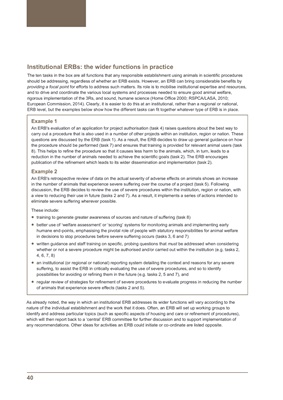
40
Institutional ERBs: the wider functions in practice
The ten tasks in the box are all functions that any responsible establishment using animals in scientific procedures
should be addressing, regardless of whether an ERB exists. However, an ERB can bring considerable benefits by
providing a focal point for efforts to address such matters. Its role is to mobilise institutional expertise and resources,
and to drive and coordinate the various local systems and processes needed to ensure good animal welfare,
rigorous implementation of the 3Rs, and sound, humane science (Home Office 2000; RSPCA/LASA, 2010;
European Commission, 2014). Clearly, it is easier to do this at an institutional, rather than a regional or national,
ERB level, but the examples below show how the different tasks can fit together whatever type of ERB is in place.
Example 1
An ERB's evaluation of an application for project authorisation (task 4) raises questions about the best way to
carry out a procedure that is also used in a number of other projects within an institution, region or nation. These
questions are discussed by the ERB (task 1). As a result, the ERB decides to draw up general guidance on how
the procedure should be performed (task 7) and ensures that training is provided for relevant animal users (task
8). This helps to refine the procedure so that it causes less harm to the animals, which, in turn, leads to a
reduction in the number of animals needed to achieve the scientific goals (task 2). The ERB encourages
publication of the refinement which leads to its wider dissemination and implementation (task 2).
Example 2
An ERB's retrospective review of data on the actual severity of adverse effects on animals shows an increase
in the number of animals that experience severe suffering over the course of a project (task 5). Following
discussion, the ERB decides to review the use of severe procedures within the institution, region or nation, with
a view to reducing their use in future (tasks 2 and 7). As a result, it implements a series of actions intended to
eliminate severe suffering wherever possible.
These include:
training to generate greater awareness of sources and nature of suffering (task 8)
better use of "welfare assessment" or "scoring" systems for monitoring animals and implementing early
humane end-points, emphasising the pivotal role of people with statutory responsibilities for animal welfare
in decisions to stop procedures before severe suffering occurs (tasks 3, 6 and 7)
written guidance and staff training on specific, probing questions that must be addressed when considering
whether or not a severe procedure might be authorised and/or carried out within the institution (e.g. tasks 2,
4, 6, 7, 8)
an institutional (or regional or national) reporting system detailing the context and reasons for any severe
suffering, to assist the ERB in critically evaluating the use of severe procedures, and so to identify
possibilities for avoiding or refining them in the future (e.g. tasks 2, 5 and 7), and
regular review of strategies for refinement of severe procedures to evaluate progress in reducing the number
of animals that experience severe effects (tasks 2 and 5).
As already noted, the way in which an institutional ERB addresses its wider functions will vary according to the
nature of the individual establishment and the work that it does. Often, an ERB will set up working groups to
identify and address particular topics (such as specific aspects of housing and care or refinement of procedures),
which will then report back to a "central" ERB committee for further discussion and to support implementation of
any recommendations. Other ideas for activities an ERB could initiate or co-ordinate are listed opposite.